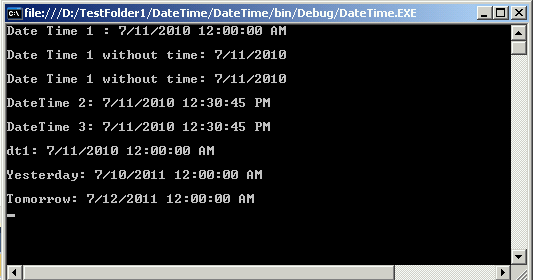Using Date type in VB.NET
Date Type use to represent date and time.
Date type is used to represent date, time and both date and a time with values ranging from 12:00:00 midnight, January 1, 0001 C.E. (Common Era) to 11:59:59 P.M., December 31, 9999 C.E. Date part represents only date, month and year between 1/1/1 to 31/12/9999. Time part represents time of a day in millisecond unit. Time value can be either negative or positive.
Code
Module Module1
Sub Main()
Dim d1 As New Date(2010, 7, 11)
Console.WriteLine("Date Time 1 : {0}", d1)
Console.WriteLine()

'Date time using String Format.
Console.WriteLine("Date Time 1 without time: {0:d}", d1)
Console.WriteLine()
'Date time using String Format.
Dim format As String = [String].Format("{0:d}", d1)
Console.WriteLine("Date Time 1 without time: {0}", format)
Console.WriteLine()
Dim d2 As New Date(2010, 7, 11, 12, 30, 45)
Console.WriteLine("DateTime 2: {0}", d2)
Console.WriteLine()
Dim d3 As New Date(2010, 7, 11, 12, 30, 45,10)
Console.WriteLine("DateTime 3: {0}", d3)
Console.WriteLine()
Dim d4 As New Date(2010, 7, 11)
Console.WriteLine("dt1: {0}", d4)
Console.WriteLine()
Dim Yesterday As Date = GetYesterdayDateTime()
Console.WriteLine("Yesterday: {0}", Yesterday)
Console.WriteLine()
Dim Morrow As Date = GetTomorrowDateTime()
Console.WriteLine("Tomorrow: {0}", Morrow)
Console.ReadLine()
End Sub
Private Function GetYesterdayDateTime() As Date
Return Date.Today.AddDays(-1)
End Function
Private Function GetTomorrowDateTime() As Date
Return Date.Today.AddDays(1)
End Function
End Module
Output
